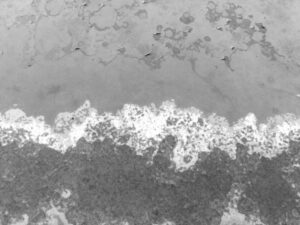Cooling towers are critical to maintaining efficiency in HVAC and industrial processes. However, they are prone to specific types of corrosion that can significantly impact performance and longevity. Among the most common issues are white rust and galvanic corrosion. While both are different forms of corrosion, they share similarities in how they affect cooling tower components and water systems.
In this post, we’ll explore what white rust and galvanic corrosion are, how to identify them, and best practices for prevention and treatment.
What is White Rust?
White rust is a specific type of corrosion that occurs on galvanized steel surfaces exposed to water. It appears as a white, powdery substance primarily consisting of zinc hydroxide. This corrosion happens when the protective zinc layer on galvanized steel reacts with water and oxygen, leading to the deterioration of the zinc coating.
Causes of White Rust
- Soft Water Conditions: White rust is more likely in water with low hardness and alkalinity levels.
- High pH Levels: pH levels above 8.5 increase the likelihood of zinc dissolution.
- Improper Passivation: Newly installed galvanized components need proper chemical passivation to form a stable, protective oxide layer.
- Exposure to Stagnant Water: Standing water on galvanized surfaces creates favorable conditions for corrosion.
What is Galvanic Corrosion?
Unlike white rust, galvanic corrosion occurs when two dissimilar metals come into electrical contact in an electrolyte like water. Common combinations like copper and steel or aluminum and stainless steel in cooling towers can create this corrosive reaction.
Symptoms of White Rust and Galvanic Corrosion
White Rust:
- Powdery white deposits on galvanized steel components.
- Reduced structural integrity of cooling tower parts.
- Premature failure of galvanized coatings.

Galvanic Corrosion:
- Localized pitting or thinning of the more anodic metal (e.g., steel or aluminum).
- Reddish or greenish stains due to metal oxides.
- Leaks in pipes or other system components.

Prevention Strategies
White Rust:
1. Passivation of New Galvanized Surfaces:
Passivation chemicals containing phosphates or chromates should be used during startup to stabilize the zinc layer.
2. Water Chemistry Control:
Maintain pH levels between 6.5 and 8.0.
Ensure sufficient water hardness and alkalinity (e.g., calcium hardness levels above 50 ppm).
3. Proper Design and Maintenance:
Ensure surfaces are free of stagnant water and maintain adequate flow rates to avoid localized corrosion.
Galvanic Corrosion:
1. Material Compatibility:
Use similar metals wherever possible to reduce potential differences.
2. Dielectric Isolation:
Install non-conductive gaskets or spacers between dissimilar metals.
3. Cathodic Protection:
Add sacrificial anodes to protect more vulnerable metals.
4. Water Treatment:
Use corrosion inhibitors like molybdate, silicates, or phosphates to form protective layers.
Treatment of Existing Corrosion
White Rust:
1. Mechanical Cleaning:
Use non-abrasive brushes or pads to remove white rust deposits.
2. Chemical Cleaning:
Apply diluted solutions of mild acids (e.g., citric or phosphoric acid) to dissolve zinc hydroxide.
3. Re-passivation:
Reapply passivation treatments to stabilize the zinc coating.
Galvanic Corrosion:
1. Replace or Repair Components:
Severely corroded parts should be replaced promptly to prevent further damage.
2. Protective Coatings:
Apply epoxy, polymer, or other corrosion-resistant coatings to exposed metal surfaces.
3. Water Chemistry Adjustment:
Lower water conductivity and maintain proper chemical balances.
Monitoring and Maintenance
Both white rust and galvanic corrosion require proactive management. Here are some best practices to keep your cooling tower in optimal condition:
- Regular Inspections: Check metal surfaces, galvanized components, and system connections.
- Water Testing: Monitor pH, alkalinity, hardness, and conductivity to ensure water remains within the recommended ranges.
- Corrosion Coupons: Metal coupons are used to track and measure corrosion rates.
- Preventive Maintenance: Clean and repair surfaces as needed to avoid compounding damage.
Next Steps
White rust and galvanic corrosion are common yet preventable challenges in cooling tower systems. By understanding the causes, symptoms, and proper prevention methods, you can significantly extend the lifespan of your equipment and maintain operational efficiency.
Combining regular inspections with a well-managed water treatment program will help you stay ahead of these issues and ensure your cooling tower remains reliable for years to come.
